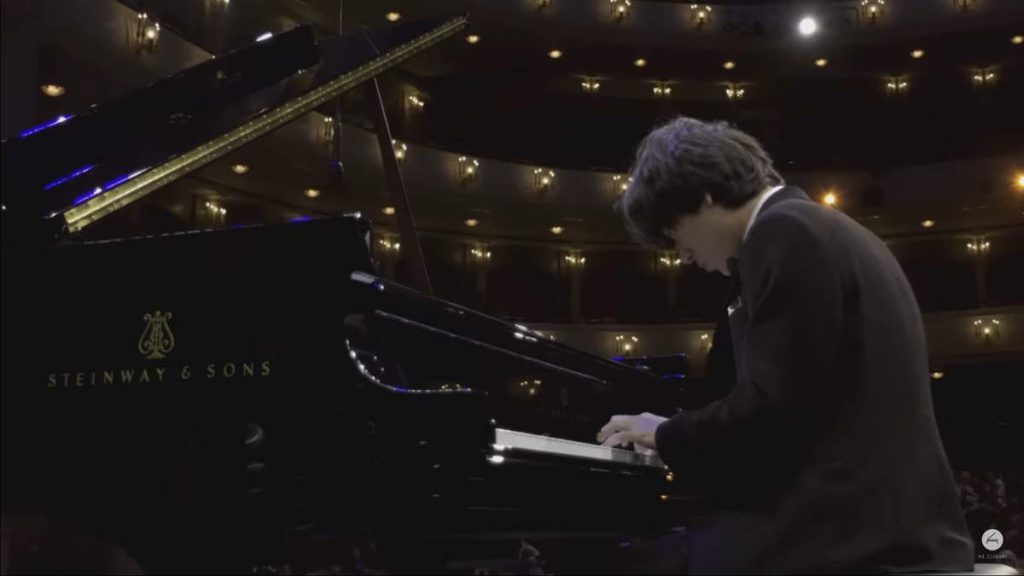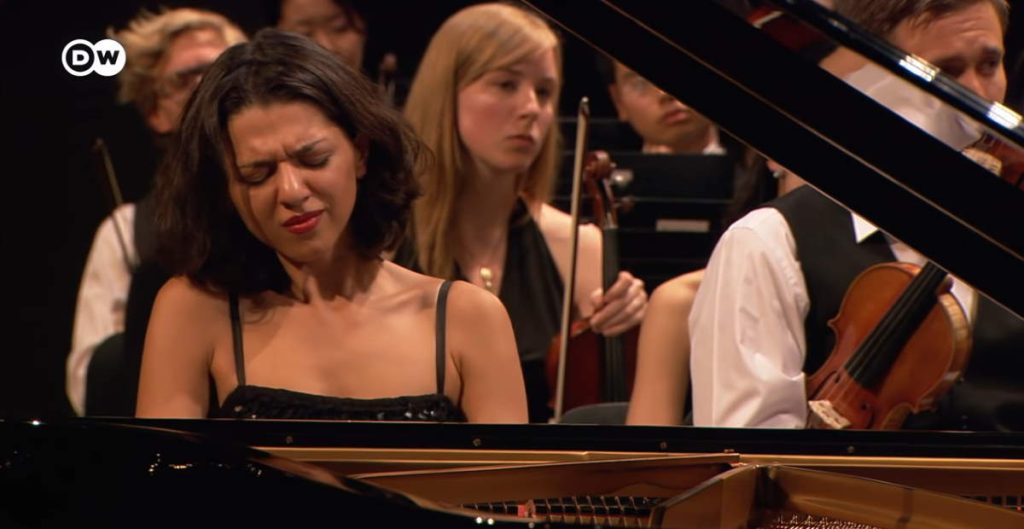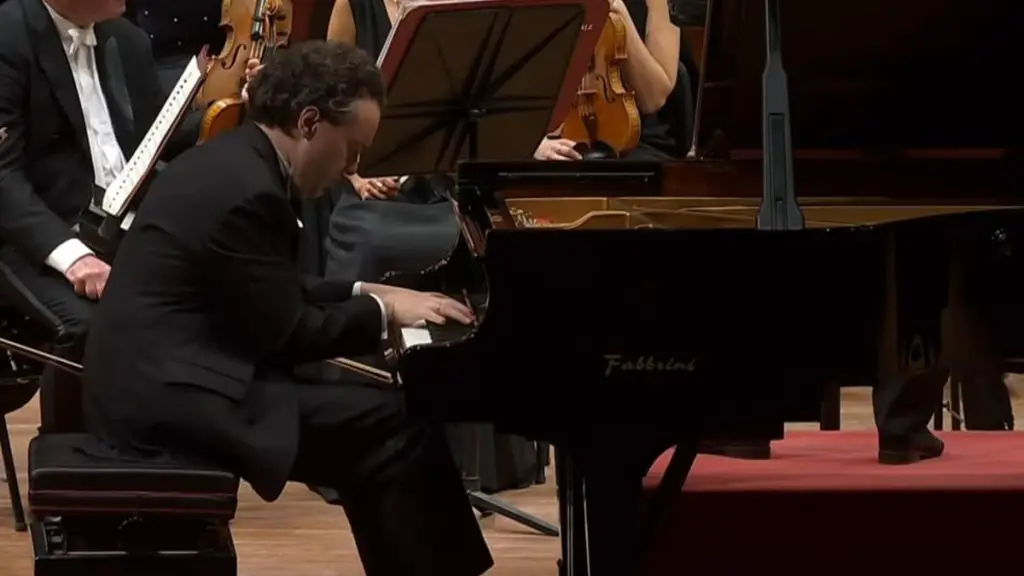Accompanied by the Berlin Radio Symphony Orchestra, Argentine classical pianist Martha Argerich performs Sergei Rachmaninoff’s Piano Concerto No. 3, Op. 30. Conductor: Riccardo Chailly. Recorded on December 5th, 1982.
Sergei Rachmaninoff’s Piano Concerto No. 3
Rachmaninoff’s Piano Concerto No. 3 in D minor, Op. 30, is one of the most renowned and challenging works in the piano concerto repertoire. Composed in 1909, it was written for Rachmaninoff’s tour of the United States, where he intended to premiere it with the New York Symphony Society under the baton of Walter Damrosch. Known for its technical demands and emotional depth, the concerto quickly gained a reputation as one of the most formidable pieces for any pianist to master.
The concerto opens with a simple yet captivating theme, introduced by the piano alone, which then evolves into a complex and richly textured interplay between the soloist and the orchestra. Rachmaninoff’s signature style, characterized by lush harmonies, sweeping melodies, and intricate counterpoint, is evident throughout the work. The concerto demands a high level of virtuosity, requiring the soloist to navigate rapid passages, wide leaps, and powerful chords, all while maintaining musicality and expressive depth.
Rachmaninoff’s orchestration in this concerto is particularly noteworthy. He creates a balanced and dynamic conversation between the piano and the orchestra, allowing each to shine while complementing the other. The orchestral writing is rich and varied, providing a solid foundation that enhances the piano’s elaborate lines.
The concerto’s emotional range is vast, moving from introspective and lyrical moments to dramatic and intense passages. This emotional complexity, combined with the technical challenges, makes the piece a true test of a pianist’s skill and interpretative abilities. The concerto has been performed and recorded by many of the world’s greatest pianists, each bringing their own unique interpretation to its nuances and intricacies.
Rachmaninoff’s Piano Concerto No. 3 is scored for 2 flutes, 2 oboes, 2 clarinets, 2 bassoons, 4 horns, 2 trumpets, 3 trombones, tuba, timpani, bass drum, snare drum, cymbals, piano, and strings.
Movements
1. Allegro ma non tanto (D minor)
The first movement revolves around a diatonic melody that soon develops into a complex pianistic figuration. The second theme opens with quiet exchanges between the orchestra and the piano before fully diving into a slower theme in a major key. The first part of the first theme is restated before the movement is pulled into a loud development section which opens with toccata-like quavers in the piano and reaches a loud chordal section.
The whole development exhibits features similar to a canon, such as an eighth note passage in the piano in which the left hand and the right hand play overlapping figures. The movement reaches a number of ferocious climaxes, especially in the cadenza. Rachmaninoff wrote two versions of this cadenza: the chordal original, which is commonly notated as the ossia, and a second one with a lighter, toccata-like style.
Both cadenzas lead into a quiet solo section where the flute, clarinet, and horn restate the first theme of the exposition, accompanied by delicate arpeggios in the piano. The cadenza then ends quietly, but the piano alone continues to play a quiet development of the exposition’s second theme before leading to the recapitulation, where the first theme is restated by the piano, with the orchestra accompanying, soon closing with a quiet, rippling coda reminiscent of the second theme.
2. Intermezzo: Adagio (F sharp minor/D flat major)
The second movement is opened by the orchestra and it consists of a number of variations around a single lush, heavily romantic melody following one another without a rigid scheme. The melody soon moves to the tonic major which is the second theme. After the first theme development and recapitulation of the second theme, the main melody from the first movement reappears, before the movement is closed by the orchestra in a manner similar to the introduction.
Then, the piano gets the last word with a short “cadenza-esque” passage which moves into the last movement without pause. Many melodic thoughts of this movement allude to Rachmaninoff’s second piano concerto, third movement, noticeably the Russian-like, E-flat major melody.
3. Finale: Alla breve (D minor → D major)
The third movement is quick and vigorous and contains variations on many of the themes that are used in the first movement, which unites the concerto cyclically. However, after the first and second themes it diverges from the regular sonata-allegro form. There is no conventional development; that segment is replaced by a lengthy digression using the major key of the third movement’s first theme, which leads to the two themes from the first movement.
After the digression, the movement recapitulation returns to the original themes, building up to a toccata climax somewhat similar but lighter than the first movement’s ossia cadenza and accompanied by the orchestra. The movement concludes with a triumphant and passionate second theme melody in D major. The piece ends with the same four-note rhythm – claimed by some to be the composer’s musical signature – as the composer’s second concerto.
Sources
- Piano Concerto No. 3 (Rachmaninoff) on Wikipedia
- Rachmaninov – Piano Concerto No. 3 in D minor on classicfm.com
- Concerto for Piano and Orchestra No. 3 in D minor, Op. 30 on classical.net


